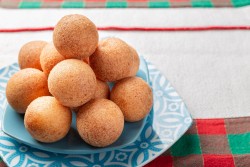
Colombia is a country with a rich history, diversity, and a vibrant culinary scene. One of the most iconic delicacies emerging from this beautiful South American nation is the buñuelo. These delightful fried dough balls are not just a treat for the taste buds but also carry a piece of the Colombian soul with them.
December in Colombia would not be complete without the presence of buñuelos on the festive table. These delicious fried balls are more than just a snack; they represent a fusion of flavor and history.
What makes buñuelos unique is their perfect balance between sweet and savory, making them irresistible. This delicacy, found in various forms throughout Colombia, showcases the country's culinary creativity. In Bogotá, for instance, it's presented as a golden ball, made with cornstarch, cassava starch, and queso costeño. This version boasts a crispy exterior and a soft, sponge-like interior. In contrast, in Cartagena, the buñuelo transforms into a light dough ball made of black beans.
While buñuelos are strongly associated with December and Christmas celebrations, they are a treat that can be found year-round in many cafes and street stalls.
The origin of this emblematic bite from Colombian gastronomic culture is fascinating. The corn variant of the buñuelo was introduced by the Spaniards, who in turn were inspired by the Arabs during their stay on the Iberian Peninsula. The blend of American dough and African frying technique is a prime example of Colombia's culinary fusion. The coastal buñuelo version is locally inspired by the akara or akkra from Nigeria and the Gulf of Benin. The ingredients and preparation method remain largely unchanged, passed down by African chefs.
Since colonial times, buñuelos have firmly rooted their place in the heart of Colombian culinary traditions, just like empanadas. Both dishes have been enriched with Colombia's unique identity and are now integral parts of traditional cuisine.
The entire process, from kneading to tasting, is a pleasure. The buñuelo is perfect for breakfast, a break during a hectic day, or dinner on a cold evening, especially when paired with hot chocolate or aguapanela.
For those struggling to find the traditional queso costeño, the Turkish cheese "boreklik" can serve as a suitable substitute, further enhancing the accessibility and spread of this dish.
The Colombian buñuelo is not just any dish; it's a culinary representative of our culture, full of flavor and passion.
Colombian Buñuelos Recipe

| Category: | Appetizers |
| Cooking Time: | 40 min |
| Portions: |
15
|
| Kitchen: | Colombian Cuisine |
| Cost Range: | Cheap |
Ingredients:
-
250 gr Queso costeño
-
120 gr Cornstarch
-
10 gr Tapioca starch
-
1 tbsp Granulated sugar
-
1 pinch Salt
-
2 Eggs
-
1 Milk
-
1 oil
Instructions:
- Grate the cheese: Grate the cheese into a large bowl.
- Add dry ingredients: Incorporate the cornstarch, sugar, salt, and tapioca starch into the grated cheese and mix well.
- Add eggs: Introduce the eggs and blend everything thoroughly. If the mixture appears too dry, add a touch of milk to achieve a moister consistency. You're aiming for a consistency that holds together but isn't sticky.
- Form the buñuelos: Take small amounts of the mixture and shape them into tiny balls. Endeavor to make them as round as possible.
- Frying: Heat the oil in a deep frying pan to about 180°C (356°F). Ensure you have enough oil so the buñuelos can float without touching the pan's bottom. Add the buñuelos and fry until they turn golden brown and crispy, which typically takes around 3-4 minutes.
- Drain: Using a slotted spoon, remove the buñuelos from the oil and let them drain on paper towels.
Queso Costeño or Queso Fresco (If you can't find these, you might try a blend of feta and mozzarella as a substitute).
